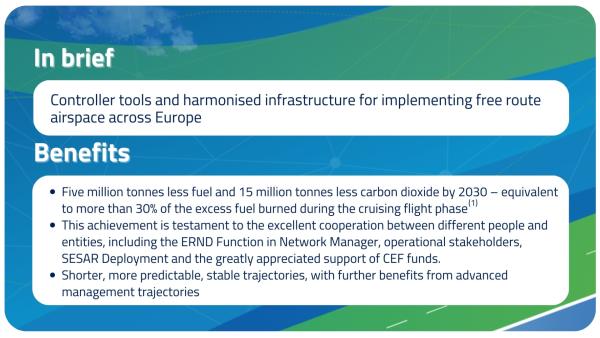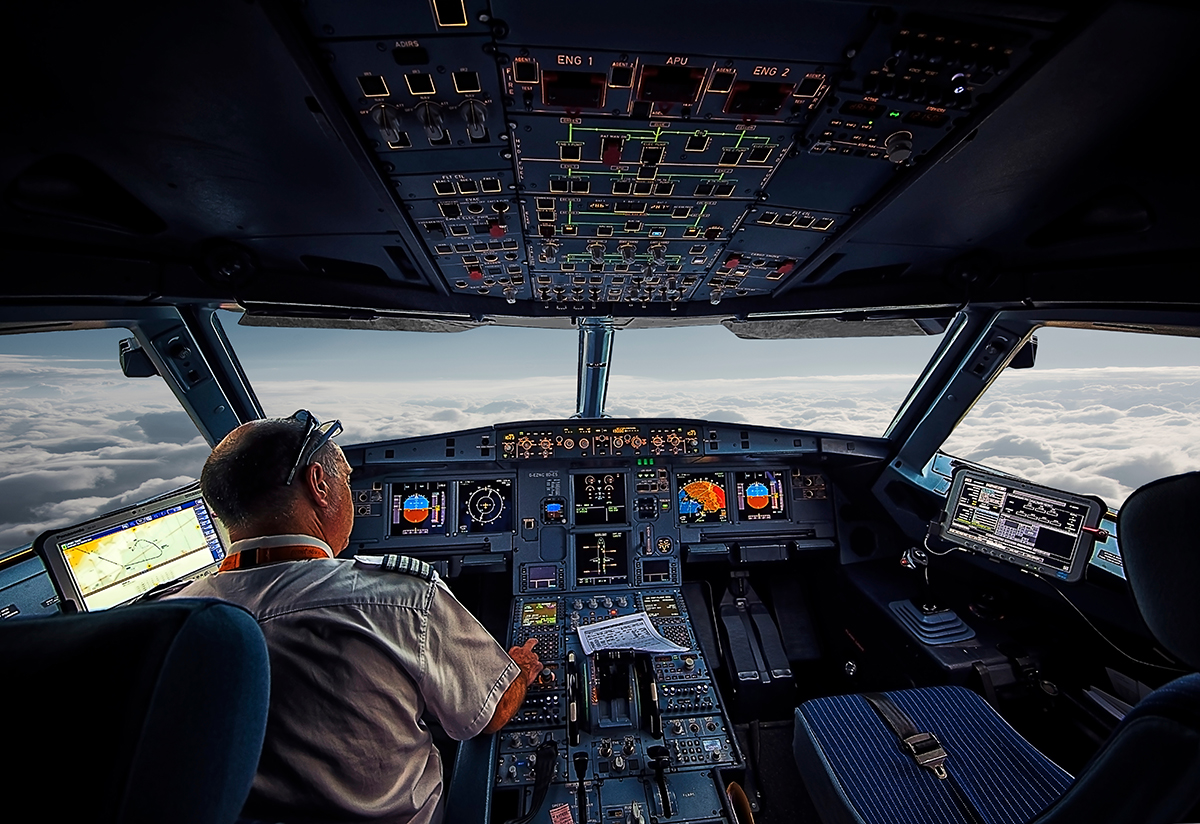Efficient free route airspace for Europe
From airspace redesign to harmonised air traffic management platforms and trajectory information, SESAR innovation is driving the shift to free route airspace.
Free route airspace, which enables airspace users to plan and fly optimum trajectories, brings Europe closer to its long-term goal of seamless, trajectory-based operations. By co-funding research and demonstration projects, and developing and deploying technology, SESAR plays a central role in implementing free route airspace across Europe.

Navigating via fixed routes leads to bottlenecks, particularly during busy periods, with some aircraft being assigned less efficient altitudes or longer routes that have a more substantial environmental impact. This in turn requires more frequent radio transmissions and control sectors, both of which increases a controller’s workload.
Free route airspace (FRA) offers an alternative.
FRA allows airspace users to plan and fly optimum trajectories above flight level 245. Instead of flying a predefined route, with FRA, an operator can choose their route subject to a few limitations (e.g., rules depicted in the RAD, fixed entry and exit points, military zones, danger areas).
The benefits of implementing FRA are numerous. For example, when flying fixed routes, aircraft fly an average of 20km further than the most direct route between two points, with limited opportunity to take advantage of favourable winds and efficient routes. In contrast, by enabling more direct flight routes, it is estimated that FRA will save approximately six million tonnes of fuel and 20 million tonnes of carbon dioxide over the coming decade(1). The achievement is merit of the excellent cooperation between different people and entities: the European Route Network Design (ERND) Function in the EUROCONTROL Network Manager, the operational stakeholders, SESAR Deployment Manager and the greatly appreciated support of CEF funds. While the European Union has mandated that FRA be fully implemented across Europe by the end of 2025, doing so is easier said than done. That’s because Europe’s fragmented airspace – managed by 37 separate air navigation service providers (ANSPs) – is a challenging environment for introducing free route airspace.
To help overcome these challenges, SESAR has brought together stakeholders, industry and EU finance to co-create solutions for ensuring optimised routing in European skies.
The solution
SESAR developed new controller tools and harmonised infrastructure that allow ANSPs to extend free route airspace’s implementation across Europe(2). These include:
- User preferred routing (SESAR Solution #65)(3)
- Extended projected profile (SESAR Solution #115)(4)
- System wide information management (SWIM)(5)
The results
Operating a free route environment ensures more stable trajectories and thus delivers improved traffic predictability. Flight paths become more spread out and potential conflict areas are reduced. Airspace users also have access to more direct routes, saving track miles and reducing fuel consumption and emissions.
The details
- In addition to area control centre modernisation, SESAR coordinated EUROCONTROL Network Manager system upgrades in support of FRA. This ensured appropriate network connectivity and coordination(7) for the implementation of cross-border free route airspace.
- FRA implementation is the outcome of cooperation between different people and entities. It benefits from the EUROCONTROL Network Manager’s route network and airspace design function and the engagement of operational stakeholders.
- The SESAR FRA Solution is on track to being available everywhere around the clock from the end of 2025, in line with Commission Implementing Regulation (EU) 2021/116(6).
In action
Thanks in part to the tools and infrastructure developed with SESAR’s support, by the end of 2024, approximately 75 ACCs have either fully or partially implemented free route airspace operations. Examples include:
- The 4-FLIGHT flight data processing system, which was co-financed by SESAR, is delivering key technologies at French area control centres to support free route airspace, where some sectors demonstrate potential airspace capacity increases of 10-12%.
- Two additional free route cells were introduced in France in February 2024 within the airspaces managed by Reims and Marseille Area Control Centres (ACCs).
- Five ANSPs have deployed common infrastructure with SESAR’s support as part of the COOPANS(7) project. This infrastructure delivers a standardised human machine interface for free route airspace and other services, including arrival management, SWIM and flexible airspace management.
- SESAR-validated trajectory-based free routing (SESAR project PJ06(8)) helped support the expansion of south-east Europe free route airspace (SEEFRA(9)), which now spans six adjacent countries and will soon extend from the Black Forest to the Black Sea(10).
- Thanks to its adoption of this new technology, the Borealis Alliance is implementing cross-border free route airspace across nine countries in Northern Europe (11).


References
- Eurocontrol Network Manager estimated savings from full implementation of free route airspace
- SESAR #PJ.06.01: Optimised traffic management to enable Free Rerouting in high and very high complexity cross border environments
- SESAR Solution #65: User preferred routing
- SESAR Solution #115: Extended projected profile availability on ground
- SESAR Solution #46: SWIM Yellow profile
- Free route airspace gives users the freedom to plan a route in Europe’s airspace
- SESAR AF3: COPANS
- SESAR PJ06: Trajectory-based free routing
- SESAR AF3: Network Manager
- SESAR AF3: Free route airspace from the Black Forest to the Black Sea
- SESAR AF3: Borealis Free Route Airspace

